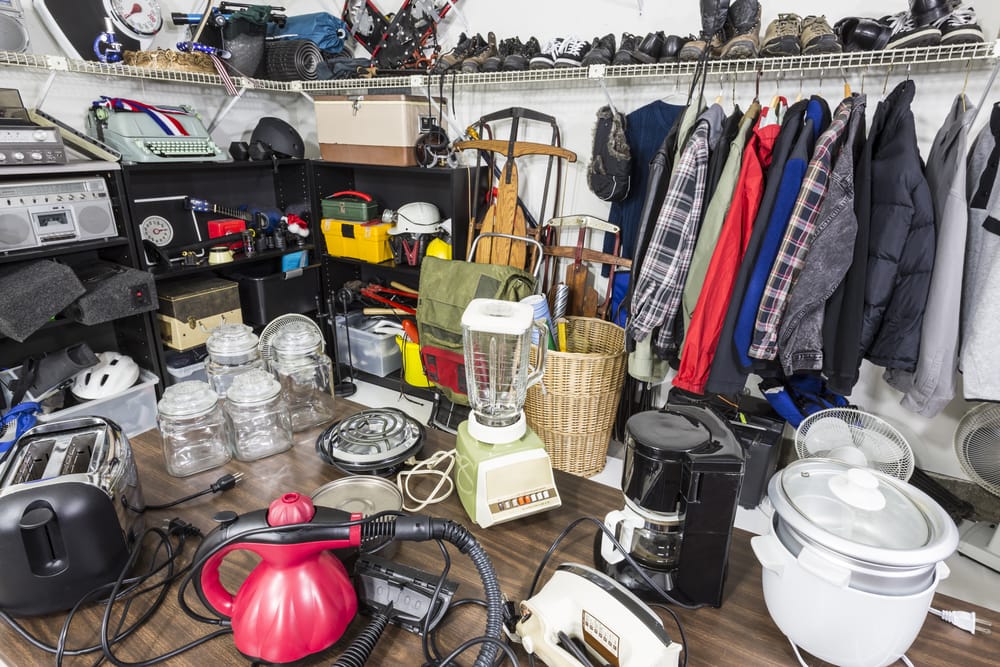There are all kinds of benefits to downsizing in your golden years — lower energy bills, a smaller space to clean and maintain, and the potential of moving closer to loved ones. It’s a wonderful way to open the door to the next stage of your life. Even so, decluttering and downsizing can be a difficult and sometimes painful experience for older adults. Saying goodbye to the home they’ve raised a family in doesn’t come easily.

This guide is designed to make the downsizing process as simple as possible for aging adults and their loved ones. It will help you prepare for the transition, as well as offer advice to loved ones on what they can do to help. Keep the lines of communication open, take it one step at a time, and don’t rush into anything before you’re ready.
Step One: Determine the area and size of the new home
It’s important to establish exactly where your loved one is headed. Not only will it affect just how much they should (or must) declutter and downsize, it adds an exciting element to the process. So whether they want to move to Dallas, TX to live with loved ones, or downsize to a condo in Miami, instead of focusing on leaving their old home behind, your downsizing parent can look forward to the new one.
Of course, where the older adult moves to will depend on any number of factors. Mobility and ability restrictions, caregiving needs, location of loved ones, and budget will all play a role. Your loved one’s preferences are also crucial to the equation and should be taken into consideration at each step. There will likely need to be compromises, especially if budget concerns are an issue, so be prepared to have multiple conversations to work out all the details. Keep in mind that the arrangements can look just about any way you want them to — many retirement communities and assisted living facilities offer personalized options to meet any need or comfort — so it’s important to make sure everyone feels comfortable with them.
There are five main options for seniors looking to downsize:
- Buying a smaller house or condo
- Renting a smaller home
- Moving in with a loved one (adult child, sibling, etc.)
- Moving into a retirement community
- Entering assisted living
The sooner you discuss what decluttering and downsizing will actually look like, the more time everyone will have to evaluate all of the options. Don’t force the conversation if your loved one seems resistant to the idea; unless your aging parent or family member has had a recent medical or caregiving issue that could hinder their quality of life, there’s no need to rush into talking about it. Bring the topic up again at a later date, potentially with additional support from family or friends. It shouldn’t feel like an intervention or anyone trying to make decisions for your loved one, but a group of people who genuinely want to help figure out a positive solution to their living situation.
Step Two: Declutter and organize
It’s amazing the number of things you can acquire over the course of a lifetime. From an endless array of dishes to closets full of linens to the many mementos and knickknacks of a life well-lived, addressing where all these items will go can be overwhelming. It’s also an incredibly emotional process for everyone involved. These aren’t just objects, they’re memories; they’re what’s made the house a home for all these years. It’s important to acknowledge and respect this loss. Go into the process prepared to part with plenty, but giving yourself room to keep the items that mean most.
The most straightforward way to sort through items is to ask yourself four questions about the item:
- Do I need it or want it?
- Does it have sentimental value?
- Do I use it often?
- Do I have another item that performs the same function?

Do I need it or want it?
You don’t have to throw away everything you could live without, but you should be pretty strict about your definition of need. If you have a bread maker that’s been sitting in the cabinet untouched for years, don’t feel like you “should” keep it just because it was a Hanukkah gift. Think realistically about the years ahead: will you use it more than a few times? Are you genuinely excited for the few times you’ll use it? Will it make an important difference in your life to hold onto the item? It’s okay to say yes, but it is also okay to decide you don’t need it. decluttering and downsizing is about simplifying, so make a decision and feel confident in sticking to it.
Does it have sentimental value?
The hardest items to part with will be the ones directly tied to beloved memories with your family and friends. Still, if you kept absolutely everything of sentimental value, decluttering and downsizing would be impossible. Use the packing and sorting process as a way to reflect and let go. As you and a loved one go through your things, talk about them and the memories they conjure up.
Do I use this item often?
There are going to be some items you’re simply used to having around, but ultimately don’t use very much. Think about your day-to-day routine: which items do you use the most? When looking around your house, which objects have been merely functional décor? Additionally, consider whether where you’re going will have a valuable replacement — just because you’ve always used a traditional toaster doesn’t mean you can’t adapt to your daughter’s toaster oven, for instance. Continue to be realistic about the future, keeping in mind that there might be someone else who would get much more use out of the item than you might.
Do I have another item that performs the same function?
Whether it’s two blenders or a dozen winter coats, duplicate items are the easiest way to declutter and downsize. Choose the newest or best-functioning electronics, and a reasonable amount of more practical items like towels, blankets, outerwear, and other clothing. Use the opportunity to clean out your closet and embrace the opportunity to minimize. Hiring a senior move manager, professional organizer, or declutterer can make a world of difference during this process and make the transition much more simple.
Step 3: Find new homes for the items you aren’t keeping
Moving expenses can become pricey. Yard sales are a great way to make some extra money to help fund the move, and a great way to find new homes for your things quickly. Choose a day that’s likely to be nice, even if it’s somewhat far in the future. Having your yard sale on a nice day is likely to draw in more customers who are looking for bargains.
Donate any remaining items that did not sell during your yard sale. Many charities and organizations can even pick up boxes directly from your home. It can feel impersonal and somewhat distressing sometimes — even with a yard sale, your items tend to go to neighbors you’re familiar with — but it’s important to focus on the end result. Someone in need will truly benefit from your donation and appreciate it each and every day.

Step 4: Prepare for the move
After you have taken the time to declutter and get rid of unwanted items you can start to think about packing and making the move to your new home. Moving can be stressful and difficult. Hiring a senior move manager to assist you with this transition can be very beneficial. They can help make your move as stress-free as possible and will be there by your side throughout the entire process.
Step 5: Say goodbye to the house
Just as aging adults have to say goodbye to their possessions, the time will come to say goodbye to the house, as well. It will be a difficult process, but one with plenty of love and support from family and friends.
The truth is, there’s not necessarily a right or wrong way to say goodbye to the family home. Discuss what will work best for your family in an open and honest setting; don’t feel ashamed if you’re having trouble. It’s vital that the entire family supports one another throughout the decluttering and downsizing process, so don’t be afraid to ask for or offer help.
However the goodbyes are said, make it a point to bid farewell. You’re closing a major, important chapter of your life. It’s OK to feel sad, even as if you’ve suffered a loss, but don’t lose sight of the exciting next step that lies ahead.
Step 6: Make the transition
No matter where you are headed, your new home won’t feel like home right away. Do what you can to bring in the most important items first, those that will make you feel especially comforted. Move-in day should be a family affair, even if you already have help from a senior move manager or movers. Any family member who is able to should stop by to help out, bring food and refreshments, troubleshoot issues, and simply make the occasion a happy one. Keep the mood as light and exciting as possible: focus on the fact that it’s a new beginning rather than an end.
You should check in on your loved ones regularly to discuss how things are going. You don’t have to stop by every day, but a nightly call for the first week or two can certainly make aging adults feel less lonely. It’s especially important if they’ve just moved to an assisted living facility or nursing home. Find the balance between hovering and checking-in, even rotating responsibility among family members.
Decluttering and downsizing is often one of the best choices an aging parent can make, but it’s their decision when and if they want to. Ease into the idea and keep the conversation ongoing. It will be painful, but the inevitable sting of leaving the family home should never stop anyone from simplified and happier living.
The post Decluttering and Downsizing: A Guide for Seniors and Their Loved Ones appeared first on Redfin | Real Estate Tips for Home Buying, Selling & More.
